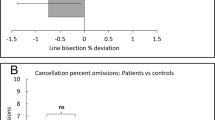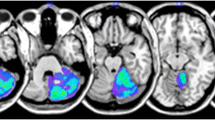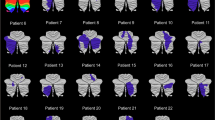Abstract
The aim of the present study was to examine cognitive functions in a group of chronic patients with focal cerebellar lesions. Both effects of localization (anterior vs. posterior lobe) and side (left vs. right cerebellar hemisphere) were of interest. Fourteen patients with infarctions within the territory of the posterior inferior cerebellar artery (PICA) and seven patients with infarctions within the territory of the superior cerebellar artery (SCA) participated. The affected lobules and nuclei were assessed based on 3D MR imaging. The right cerebellar hemisphere was affected in eight PICA and two SCA patients, the left hemisphere in six PICA and four SCA patients. One SCA patient revealed a bilateral lesion. In order to study possible lateralization of functions, subjects performed a language task as well as standard neglect and extinction tests. Moreover, two tests of executive functions were applied. There were no significant group differences apart from a verbal fluency task, in which all cerebellar patients - but especially those with right-sided lesions - were impaired. Voxel-based lesionsymptom mapping (VLSM) revealed that a lesion of the right hemispheric lobule Crus II was associated with impaired performance in the verbal fluency task. In sum, the results showed preserved cognitive abilities in chronic cerebellar patients apart from impairments of verbal fluency in patients with right-cerebellar lesions. The latter findings are in line with the assumption that the right posterolateral cerebellar hemisphere supports functions associated with verbal fluency.
Similar content being viewed by others
References
Aarsen FK, Van Dongen HR, Paquier PF, Van Mourik M, Catsman-Berrevoets CE (2004) Long-term sequelae in children after cerebellar astrocytoma surgery. Neurology 62(8):1311–1316
Ackermann H, Hertrich I, Hehr T (1995) Oral diadochokinesis in neurological dysarthrias. Folia Phoniatr Logop 47(1):15–23
Ackermann H, Mathiak K, Ivry RB (2004) Temporal organization of “internal speech” as a basis for cerebellar modulation of cognitive functions. Behav Cogn Neurosci Rev 3(1):14–22
Ackermann H, Wildgruber D, Daum I, Grodd W (1998) Does the cerebellum contribute to cognitive aspects of speech production? A functional magnetic resonance imaging (fMRI) study in humans. Neurosci Lett 247:187–190
Amarenco P (1991) The spectrum of cerebellar infarctions. Neurology 41(7):973–979
Bates E, Wilson SM, Saygin AP, Dick F, Sereno MI, Knight RT, Dronkers NF (2003) Voxel-based lesion-symptom mapping. Nat Neurosci 6(5):448–450
Cabeza R, Nyberg L (2000) Imaging cognition II: an empirical review of 275 PET and fMRI studies. J Cogn Neurosci 12(1):1–7
Chen SH, Desmond JE (2005) Cerebrocerebellar networks during articulatory rehearsal and verbal working memory tasks. Neuroimage 24(2):332–338
Dimitrov M, Grafman J, Kosseff P, Wachs J, Always D, Higgins J, Litvan I, Lou JS, Hallett M (1996) Preserved cognitive processes in cerebellar degeneration. Behav Brain Res 79(1–2):131–135
Dronkers NF, Wilkins DP, Van Valin RD, Jr Redfern BB, Jaeger JJ (2004) Lesion analysis of the brain areas involved in language comprehension. Cognition 92(1–2):145–177
Exner C, Weniger G, Irle E (2004) Cerebellar lesions in the PICA but not SCA territory impair cognition. Neurology 63:2132–2135
Fabbro F, Tavano A, Corti S, Bresolin N, De Fabritiis P, Borgatti R (2004) Long-term neuropsychological deficits after cerebellar infarctions in two young adult twins. Neuropsychologia 42(4):536–545
Fiez JA, Petersen SE, Cheney MK, Raichle ME (1992) Impaired non-motor learning and error detection associated with cerebellar damage A single case study. Brain 115(Pt1):155–178
Fink GR, Marshall JC, Shah NJ, Weiss PH, Halligan PW, Grosse-Ruyken M, Ziemons K, Zilles K, Freund HJ (2000) Line bisection judgments implicate right parietal cortex and cerebellum as assessed by fMRI. Neurology 54(6):1324–1331
Fink GR, Marshall JC, Weiss PH, Zilles K (2001) The neural basis of vertical and horizontal line bisection judgements: an fMRI study of normal volunteers. Neuroimage 14(12):59–67
Frank B, Schoch B, Hein-Kropp C, Dimitrova A, Hovel M, Ziegler W, Gizewski ER, Timmann D (2006) Verb generation in children and adolescents with acute cerebellar lesions. Neuropsychologia [Epub ahead of print]
Gebhart A, Petersen S, Thach WT (2000) Evidence for functional lateralization of language operations to the right posterior cerebellum. Soc Neurosci Abstr 26:1246
Gerwig M, Dimitrova A, Kolb FP, Maschke M, Brol B, Kunnel A, Boring D, Thilmann AF, Forsting M, Diener HC, Timmann D (2003) Comparison of eyeblink conditioning in patients with superior and posterior inferior cerebellar lesions. Brain 126(Pt 1):71–94
Globas C, Bosch S, Zuhlke Ch, Daum I, Dichgans J, Burk K (2003) The cerebellum and cognition. Intellectual function in spinocerebellar ataxia type 6 (SCA6). J Neurol 250(12):1482–1487
Gomez Beldarrain M, Garcia-Monco JC, Quintana JM, Llorens V, Rodeno E (1997) Diaschisis and neuropsychological performance after cerebellar stroke. Eur Neurol 37(2):82–89
Gottwald B, Wilde B, Mihajlovic Z, Mehdorn HM (2004) Evidence for distinct cognitive deficits after focal cerebellar lesions. J Neurol Neurosurg Psychiatry 75(11):1524–1531
Helmuth LL, Ivry RB, Shimizu N (1997) Preserved performance by cerebellar patients on tests of word generation discrimination learning and attention. Learn Mem 3(6):456–474
Horn W (1983) Leistungsprüfsystem (LPS) Handanweisung (2 erweiterte und verbesserte Auflage). Hogrefe, Göttingen
Hubrich-Ungureanu P, Kaemmerer N, Henn FA, Braus DF (2005) Lateralized organization of the cerebellum in a silent verbal fluency task: a functional magnetic resonance imaging study in healthy volunteers. Neurosci Lett 319(2):91–94
Karnath H-O, Himmelbach M, Ku¨kerW (2003) The cortical substrate of visual extinction. Neuroreport 14(3):437–442
Malm J, Kristensen B, Karlsson T, Carlberg B, Fagerlund M, Olsson T (1998) Cognitive impairment in young adults with infratentorial infarcts. Neurology 51:433–440
Marien P, Engelborghs S, Fabbro F, De Deyn PP (2001) The lateralized linguistic cerebellum: a review and a new hypothesis. Brain Lang 79(3):580–600
Merk M (2002) Entwicklung und Implementierung PC-gestützter akustischer Analyseverfahren für die klinische Diagnostik neurogener Sprechstörungen. Dissertation Universität der Bundeswehr, München
Merk M, Ziegler W (1999) MoDiaS — A PC-based system for routine acoustic speech analysis of neurogenic speech disorders. In: Maasen B, Groenen P (eds) Pathologies of speech and language. Advances in clinical phonetics and linguistics. Whurr, London, pp 315–321
Middleton FA, Strick PL (2001) Cerebellar projections to the prefrontal cortex of the primate. J Neurosci 21(2):700–712
Molinari M, Leggio MG, Silveri MC (1997) Verbal fluency and agrammatism. Int Rev Neurobiol 41:325–339
Molinari M, Petrosini L, Misciagna S, Leggio MG (2004) Visuospatial abilities in cerebellar disorders. J Neurol Neurosurg Psychiatry 75(2):235–240
Neau JP, Arroyo-Anllo E, Bonnaud V, Ingrand P, Gil R (2000) Neuropsychological disturbances in cerebellar infarcts. Acta Neurol Scand 102:363–370
Oldfield RC (1971) The assessment and analysis of handedness: the Edinburgh inventory. Neuropsychologia 1:97–113
Petersen SE, Fox PT, Posner ML, Mintun M, Raichle ME (1989) Positron emission tomographic studies of the processing of single words. J Cogn Neurosci 1:153–170
Ravizza SM, McCormick CA, Schlerf JE, Justus T, Ivry RB, Fiez JA (2006) Cerebellar damage produces selective deficits in verbal working memory. Brain 129(Pt 2):306320
Richter S, Kaiser O, Hein-Kropp C, Dimitrova A, Gizewski E, Beck A, Aurich V, Ziegler W, Timmann D (2004) Preserved verb generation in patients with cerebellar atrophy. Neuropsychologia 42(9):1235–1246
Richter S, Schoch B, Kaiser O, Groetschel H, Hein-Kropp C, Maschke M, Dimitrova A, Gizewski E, Ziegler W, Karnath HO, Timmann D (2005) Children and adolescents with chronic cerebellar lesions show no clinically relevant signs of aphasia or neglect. J Neurophysiol 94(6):4108–4120
Richter S, Schoch B, Ozimek A, Gorissen B, Hein-Kropp C, Kaiser O, Hövel M, Wieland R, Gizewski E, Ziegler W, Timmann D (2005) Dysarthria is a rare sign in children with cerebellar tumors. Brain Lang 92(2):153–167
Riecker A, Ackermann H, Wildgruber D, Dogil G, Grodd W (2000) Opposite hemispheric lateralization effects during speaking and singing at motor cortex insula and cerebellum. Neuroreport 11(9):1997–2000
Riva D, Giorgi C (2000) The cerebellum contributes to higher functions during development — Evidence from a series of children surgically treated for posterior fossa tumours. Brain 123:1051–1061
Rorden C, Karnath HO (2004) Using human brain lesions to infer function: a relic from a past era in the fMRI age? Nat Rev Neurosci 5(10):813–819
Roskies AL, Fiez JA, Balota DA, Raichle ME, Petersen SE (2001) Taskdependent modulation of regions in the left inferior frontal cortex during semantic processing. J Cogn Neurosci 13(6):829–843
Schmahmann JD, Sherman JC (1998) The cerebellar cognitive affective syndrome. Brain 121:561–579
Scott RB, Stoodley CJ, Anslow P, Paul C, Stein JF, Sugden EM, Mitchell CD (2001) Lateralized cognitive deficits in children following cerebellar lesions. Dev Med Child Neurol 43:685–691
Silveri MC, Di Betta AM, Filippini V, Leggio MG, Molinari M (1998) Verbal short-term store-rehearsal system and the cerebellum. Evidence from a patient with a right cerebellar lesion. Brain 121:2175–2187
Smith EE, Jonides J (1999) Storage and executive processes in the frontal lobes. Science 283(5408):1657–1661
Steinlin M, Imfeld S, Zulauf P, Boltshauser E, Lövblad K-O, Ridolfi Lüthy A, Perrig W, Kaufmann F (2003) Neuropsychological long-term sequelae after posterior fossa tumour resection during childhood. Brain 126:1998–2008
Trouillas P, Takayanagi T, Hallett M, Currier RD, Subramony SH, Wessel K, Bryer A, Diener HC, Massaquoi S, Gomez CM, Coutinho P, Ben Hamida M, Campanella G, Filla A, Schut L, Timmann D, Honnorat J, Nighoghossian N, Manyam B (1997) International cooperative ataxia rating score for pharmacological assessment of the cerebellar syndrome. J Neurol Sci 45:205–211
Vokaer M, Bier JC, Elincx S, Claes T, Paquier P, Goldman S, Bartholome EJ, Pandolfo M (2002) The cerebellum may be directly involved in cognitive functions. Neurology 58(6):967–970
Weintraub S, Mesulam M-M (1985) Mental state assessment of young and elderly adults in behavioral neurology. In: Mesulam M-M (ed) Principles of behavioral neurology. FA Davis, Philadelphia, pp 71–123
Author information
Authors and Affiliations
Corresponding author
Rights and permissions
About this article
Cite this article
Richter, S., Gerwig, M., Aslan, B. et al. Cognitive functions in patients with MR-defined chronic focal cerebellar lesions. J Neurol 254, 1193–1203 (2007). https://doi.org/10.1007/s00415-006-0500-9
Received:
Revised:
Accepted:
Published:
Issue Date:
DOI: https://doi.org/10.1007/s00415-006-0500-9




